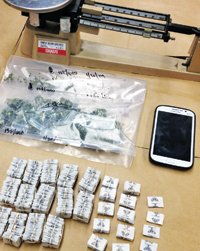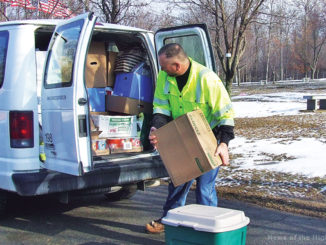
Items confiscated during a drug sweep in 2014.
A year and a half ago we reported that no place is immune to the threat of heroin and opioid addiction. That’s still true. But it doesn’t mean that the trend can’t be reversed.
On Oct. 6, we asked District Attorney David Hoovler for an update on how his office is combatting the sale and use of narcotics. The number of arrests has been high.
Narcotic
Year felony filings
2013 166
2014 218
2015 186*
*First nine months
But the county’s effort to stem the problem goes beyond the apprehension of criminals. Mr. Hoovler refers to the approach as the Three E’s — Education, Empowerment and Enforcement,
Part of the first “E” (Education) includes a campaign of public service announcements. A roadside sign, for example, provides a chilling message. “Your first choice,” it announces, “may be your last choice.”
There are three pictures on the sign. The first shows an open palm with four pills. The second features an attractive young woman with a hypodermic needle. In the third picture, the needle is on the ground, and the young woman is lying dead along side it. Near the bottom of the sign is an important fact. “Four out of five heroin users started with prescription drugs.”
The District Attorney’s office has shared that information in appearances at Town Board meetings, schools, and community events. It has also used community input and hotline tips to make more arrests for the illegal sale of prescription drugs. There were 12 in 2013, 10 in 2014, and 21 through Oct. 1 of this year.
About a fourth of the addicts who are arrested in Orange County are enrolled in drug treatment programs. “We know that there will be relapses and setbacks,” Mr. Hoovler admits. “The tough part is deciding who’s deserving and who’s not.”
Offenders who have committed violent crimes are not eligible. Candidates for treatment must have a documented history of drug use, and must be willing to subscribe to the program. About 60 percent of them graduate in 12 to 18 months.
“[Narcotic addiction] is the number 1 quality of life issue in Orange County,” Mr. Hoovler says. “Sixty to seventy percent of all crime is related to it. The numbers are staggering when you look at them. But we’re trying to hammer the problem at every level. It’s not just prosecuting. It’s also about prevention and education.”
JUST THIS WEEK
On Oct. 9 District Attorney David M. Hoovler announced the establishment of a Narcotics Eviction Program, where drug dealers can be removed from rental properties.
New York’s Real Property Law says a lease is void and tenants can be evicted if they are conducting an illegal business on the premises.
If the district attorney or a municipal attorney provides information to a landlord about a tenant involved in an illegal activity, the landlord is required to start the eviction process. If the landlord complies, he or she will receive assistance from the district attorney.
If the landlord doesn’t bring the action, or actively pursue it, the District Attorney’s Office or the municipal attorney may take over the eviction process, and may later seek an administrative fee from the landlord.



